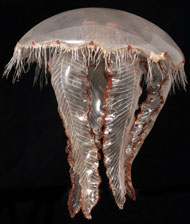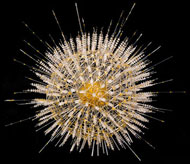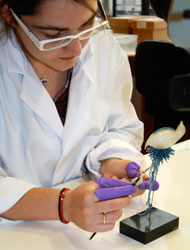Blaschka glass models
The delicate glass artworks of sea creatures crafted by father-and-son team Leopold and Rudolf Blaschka were made with impeccable accuracy and attention to detail. But with no apprentices, the secret of the Blaschkas’ techniques died with them. No one has been able to replicate their incredible work.
An artist in glass
Leopold Blaschka joined his family's jewellery and metalwork business as a young man in the mid-1800s in what is now the Czech Republic. There he learned the art of lampworking - bending and shaping glass with a gas torch.

The Blaschka models revealed an often hidden world of underwater life, such as this jellyfish, Aurelia aurita.
When Leopold's wife and father died in quick succession, his life shattered. He sailed to America to grieve. Although already a keen naturalist, he had never seen the strange animals of the open ocean, such as jellyfish, which looked as if they were made of glass. When he finally returned home, Leopold began to recreate the fragile life he had seen.
Illuminating hidden depths
His impressively accurate and beautiful work caught the eye of a museum in Dresden that was struggling to display animals without backbones, like jellyfish. Collapsed at the bottom of jars, real specimens are difficult to see.
The museum persuaded Leopold to recreate the creatures as he had seen them on his voyage, with their tentacles rippling in the ocean's current.
In 1876, Leopold was joined by his son Rudolf and the business expanded. From a small workshop in their home in Germany they made superbly crafted, life-like models for collectors across the world, from enigmatic octopuses to microscopic single-celled plankton called radiolarians.

The Blaschkas also made the beautiful diversity of microscopic organisms visible. This model shows the radiolarian Aulosphaera elegantissima.
Their models became increasingly accurate, influenced by advances in the study of marine invertebrates by scientists such as Philip Henry Gosse and Ernst Haeckel.
Between 1866 and 1889, the Natural History Museum purchased 185 Blaschka models, including sea anemones, octopuses, squid, jellyfishes, radiolarians, amoebas and corals.
Garden of glass
The growth of orders such as this inspired Rudolf to improve his knowledge of zoology at Dresden University. He also discovered a love for plants and began crafting them too.
In 1886 Harvard University commissioned an entire botanical garden of glass plants. This astonishing feat secured fame for the Blaschkas.

Museum conservator working on a Blaschka model of a Portuguese man-of-war jellyfish.
Saving these treasures
The Museum's Blaschka glass models are extremely fragile structures. They are made from many materials, not just glass. Natural resins, metals, paper and different glues can fall apart over time.
Scientists in the Museum’s Imaging and Analysis Centre have used modern techniques such as scanning electron microscopy and CT scanning to analyse the models. CT scans even make it possible to see their internal structure.
This has revealed valuable information about how the models were built, helping conservators to understand the deterioration processes better and to tailor their conservation methods.
Conservators at the Museum have carefully cleaned and repaired each of the models. This work is vital for the safe-keeping of these irreplaceable objects, which are among the most beautiful in our collections.
Further information
- Visit 3 Blaschka glass models in our new Treasures Cadogan Gallery. They will be changed every 6 months.
- Take a closer look at some of the Museum's stunning Blaschka models online.
Vote for your favourite treasure
Is this your favourite Museum treasure? Let us know by voting in our poll.
Listen to the Treasures podcast
Blaschka glass models story

Museum collections manager Miranda Lowe, glass-maker Rowan van der Holt and James Hyslop from Christie’s tell a tale of unique art and tragedy.